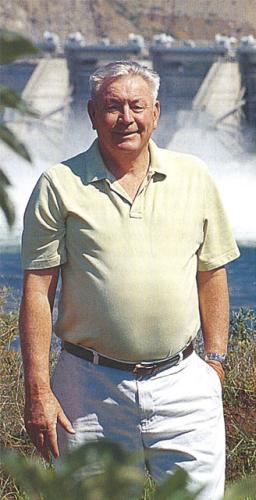Fred Valentine Shares Lessons Learned In The Quest To Grow High Quality Apples

Fred Valentine (Photo credit: Steve Kaminoff)
Most apple growers will say that as they gain more experience over the years, they can use the knowledge they attain to improve the efficiency of their orchard. But how many can say that their experience has benefited not only them, but also everyone they have worked with?
That is one thing you can see with sincerity in Fred Valentine, American Fruit Grower® and Western Fruit Grower® magazines’ 2002 Apple Grower of the YearSM.
Husband to Carol and father of three daughters, he’s been tied to the industry for years, but by no means is Fred in it simply for his own gain.
“I try to challenge and encourage the industry to grow the highest quality fruit to return the most money that the acre is able to produce,” he says, a statement that reflects the uneasy plight of growers.
Fred Valentine has been in and out of Washington apple orchards all his life, but it is his contributions to the industry that make him stand out. At a time when the industry is dealing with its share of problems, it’s nice to have a voice of confidence and reason.
It also helps to understand that Fred Valentine’s path to success has differed from that of past Apple Grower of the YearSM winners.
He’s still out there in the field like everyone else, looking for ways to improve spray techniques and harvest efficiency (he’s also influential in introducing new apple varieties such as Cameo, which is discussed more in the “The Birth of Cameo” section). He grows 14 acres of Gala, Fuji, and Golden Delicious in the heart of apple country in East Wenatchee, WA.
But everyone has their own specialty: Some strive to use the most advanced production and cultural practices, while others have a knack for developing innovative marketing strategies. As Valentine looks back on a long career in fruit, however, his goal has been simple: Use the knowledge you have to grow the highest quality fruit, and share this advice.
Setting The Stage
Roots and training are important. There’s a double meaning in that statement: It’s a proven rule in the orchard, and it’s also something that has helped define Fred Valentine’s role in the industry. Growing up on an orchard working for Gene Boswell in Peshastin, just west of Wenatchee, first got Valentine interested in fruit and working in the orchard. He attended Wenatchee Valley College, where he delved even deeper into the inner workings of an orchard while working with professor George Roberts. He spent a lot of time at the
Washington State University Research Station, focusing heavily on horticulture and entomology.
After school, Valentine moved on to Northwest Wholesale and spent three years as a fieldman before being hired as a horticulturist by Blue Star Cooperative. He stayed at Blue Star for about 35 years and helped turn them into a major packinghouse for pear growers. In 1992, he was hired by Dole Fruit as their grower relations manager. When Dole scaled back in the fruit market, Valentine turned to Stemilt Growers, where he is employed as a horticulturist.
Despite all of this movement, Fred Valentine always found time to tend to his own orchard. For 20 years, he was in a partnership with four other men (Tom Griffith, Ron Doane, Wayne Doane, and Gordon Moody) on a 65-acre orchard. But with urbanization creeping in, he opted to sell his interest in the orchard, although he kept the 14 acres he now owns for himself.
In Good Times And Bad
It’s safe to say that with all of his experience, Valentine knows a thing or two about what apple growers, and the industry as a whole, need to do to remain profitable. He’s seen the industry during its toughest times (including serving as president of the Washington State Horticultural Association during the Alar incident), and while no one has all the answers, he’s got some good ideas.
“It’s been very tough the last three years, but most growers are optimistic that things are going to get better,” says Valentine.

(Photo credit: Steve Kaminoff)
For example, he points out that this year’s crop, while still high in relative terms, should be down significantly from the 2000 crop year. This is especially true for Red Delicious, which has been overtaken in the export market by Fujis and Galas and led many growers to significantly cut down on their acreage.
“We were growing too many Red Delicious with poor color, but with overproduction, you need a super packout to make any money,” says Valentine.
He also sees challenges in harvesting. Growers know they need to deliver the highest-quality fruit, but there’s not much in the way of automatic harvesting technology for apple growers.
“It’s still a very hands-on industry, and you need to work with the resources you have,” notes Valentine.
On the marketing side, Valentine does not have much to worry about, since the apples he grows are sold by the Blue Star Growers cooperative. But he does worry how the smaller growers are going to survive. On the East Coast, many of these growers have turned to direct or roadside marketing. But that’s not much of an option in the West, where the major metropolitan markets are few and far between. It’s great if you can be recruited for a packinghouse, but that can’t happen for everyone. For these growers, Valentine says cooperatives may be the answer, as long as they are run properly.
“They can deliver a tremendous product to the market, but only if they maintain the right way of doing business — gathering small growers, pulling their crop together as a whole, and keeping their costs low,” he says.
Above all, Valentine says other growers need to develop a strong business plan that ensures they are getting the highest packout of quality fruit. With today’s costs, you can’t afford to deliver low-quality fruit, and you need to be selective with varieties.
“Tighten up on your harvest, so you’re not delivering unsellable fruit to the warehouse,” he says. Another issue Valentine is involved in is the changes in pesticides.
“We are using a much different approach now, with IPM and softer spray materials,” he points out.
One of his biggest concerns today is the loss of organophosphates, although he says researchers have done a good job at staying ahead of the game. It helps that Washington is one of the easier places to grow apples because of its desert climate.
Love Of The Game
All this work in growing your own fruit, while trying to help others, may seem like a handful. But Valentine says it’s the love of the apple industry that keeps him moving forward.
“I love what I’m doing, and I have a great desire to do better, the best that I can,” says Valentine, who notes that this passion drives all growers. “We will generally farm until we’re broke, because farming is our love, and growing apples is the highest part of that.”
Sounds like something any apple grower can relate to.
A Proven Track Record
Fred Valentine has indeed worked his way up the ladder to achieve success in the fruit industry. Here’s a sampling of some of his accomplishments:
- Past president and member of the Board of Directors for the Washington State Horticultural Association (WSHA).
- Long-time member and past president of the Washington Tree Fruit Research Commission. “One of the greatest things we ever did was improve the Golden Delicious market through our research of controlled atmosphere storage,” says Valentine. He continues to follow the commission’s work, including its tough battle in finding innovative harvesting techniques.
- Board member and Secretary/Treasurer of Tree Top Inc., the largest fruit processor cooperative in Washington. Fred Valentine’s advice to apple growers: Develop a business plan that will get rid of old varieties, and make sure you are getting a good packout while delivering only the highest-quality fruit.
- Founder and co-chair of the Washington Tree Fruit Industry Task Force, a think-tank that is constantly looking for ways to help fruit growers.
- WSHA Apple Grower of the Year in 1995
The Birth Of Cameo
It started with a simple question: “What do you think of this apple?” It has since turned Cameo into one of the hottest new apples on the market.
Ten years ago, Fred Valentine was approached by a grower and friend named Darrel Caudle, who wanted to get Fred’s opinion on a new apple. He liked it enough to encourage local grower (and 1996 Apple Grower of the YearSM) Doyle Fleming to grow more of it. Meanwhile, Fred worked with an associate named Bob Gick to come up with the best ways to grow, harvest, and store the apple. Eventually, Valentine was able to talk more of his grower friends into planting it.
“We found out that introducing a new variety to the market was much harder and more expensive than we ever thought,” says Valentine.
However, this cooperative of growers was able to patent Cameo, and turned it over to Dole Fruit, who Valentine was working for at the time. Since then, Valentine and others have worked hard to market Cameo, selling its taste and quality. It’s been a huge success for them, despite the roller coaster ride.
“At first, everyone was kind of nervous about it. Now they’re clamoring for more,” he says.
And as for Fred and Darrel? “We’ve become real close friends since we got started with it.”
Fred Valentine’s advice to apple growers: Develop a business plan that will get rid of old varieties, and make sure you are getting a good packout while










